
hashbrown
Hashbrown is a framework for building generative user interfaces in Angular and React
Stars: 229
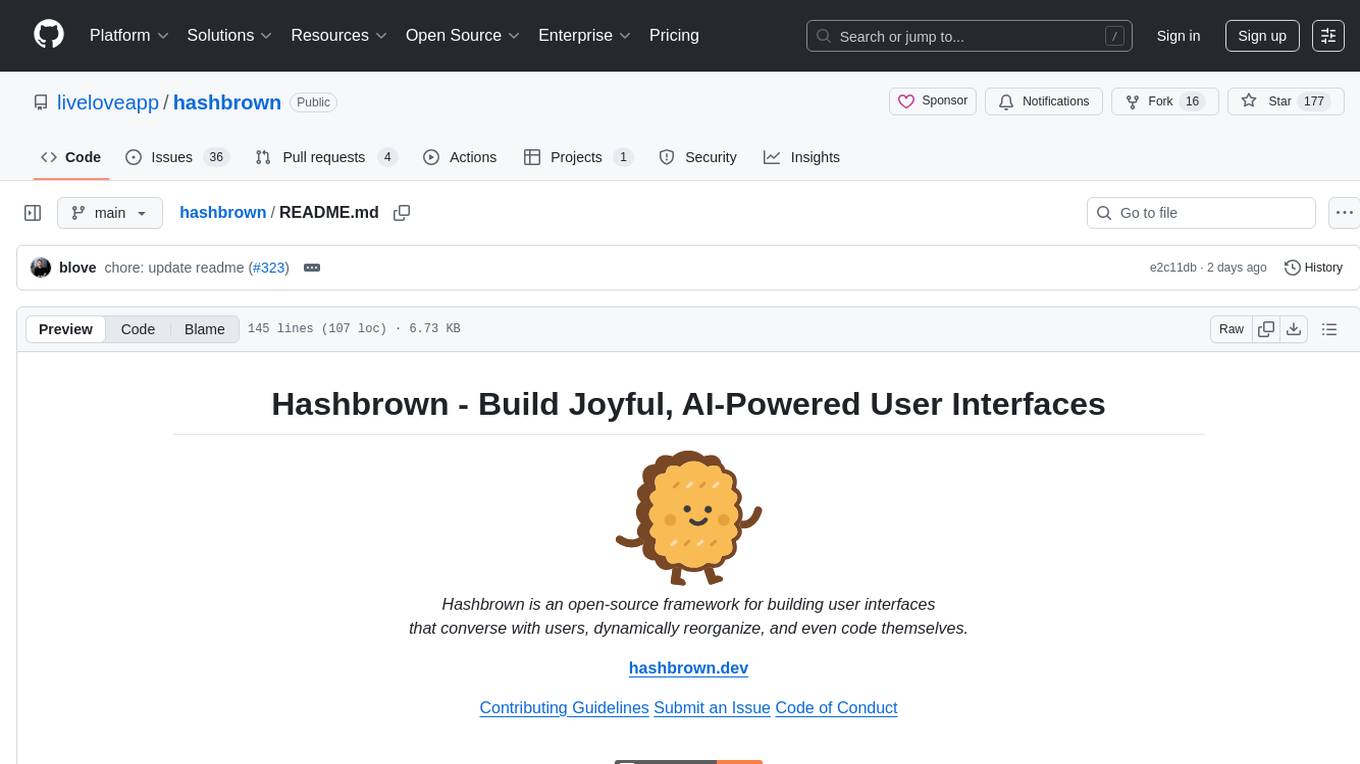
Hashbrown is a lightweight and efficient hashing library for Python, designed to provide easy-to-use cryptographic hashing functions for secure data storage and transmission. It supports a variety of hashing algorithms, including MD5, SHA-1, SHA-256, and SHA-512, allowing users to generate hash values for strings, files, and other data types. With Hashbrown, developers can quickly implement data integrity checks, password hashing, digital signatures, and other security features in their Python applications.
README:

Hashbrown is an open-source framework for building AI-powered user interfaces
that converse with users, dynamically reorganize, and even code themselves.
Submit an Issue |
Contributing Guidelines |
Code of Conduct
What is Hashbrown | Installation | Getting Started | Supported LLM Providers | Features | Walkthroughs | Core Team | Workshops and Consulting
Hashbrown is a set of core and framework-specific packages for the UI along with LLM SDK wrappers for Node backends. Hashbrown makes it easy to embed intelligence in individual features and to orchestrate and dynamically update whole applications based on real-time, natural language inputs.
Hashbrown typically needs three packages installed:
- @hashbrownai/core: a shared set of primitives for managing state to/from LLM providers
- @hashbrownai/<angular|react>: a framework-specific set of wrappers for the core primitives to easily tie Hashbrown into framework lifecycle flows
- @hashbrownai/: A provider-specific wrapper for Node backends that wraps a provider SDK to provide consistency between providers.
For example, to use Hashbrown with Angular and OpenAI's GPT models, you could install the requisite packages like so:
npm install @hashbrownai/{core,angular,openai} --saveTo use Hashbrown with React and Azure, you'd instead do:
npm install @hashbrownai/{core,react,azure} --saveHashbrown supports a (growing) list of proprietary and open-weights models via vendor-specific packages that wrap each SDK's inputs and outputs into a consistent shape for Hashbrown to consume.
They include:
Coming soon:
- Anthropic
- Vercel
Note that any model supported by a vendor's SDK will generally be usable via Hashbrown. That said, not all models (especially some older, smaller ones) will be able to handle the full feature set of Hashbrown.
Hashbrown backend SDK wrappers put a consistent API surface around varied SDK APIs, and allow you to provide API keys and model choices, as well as other vendor-specific parameters.
Hashbrown uses HTTP streaming to communicate between Node backends and UI hooks/resources.
The below example demonstrates exposing a POST endpoint /chat that:
- takes in a completion parameters, like a set of messages, schema and tool calls/definitions
- streams LLM responses back to the Hashbrown UI mechanisms
Note: the URL is configurable in Hashbrown and need not be 'chat', so long as it matches in the backend and UI.
import { HashbrownOpenAI } from '@hashbrownai/openai';
app.post('/chat', async (req, res) => {
const stream = HashbrownOpenAI.stream.text({
apiKey: process.env.OPENAI_API_KEY!,
request: req.body, // must be Chat.Api.CompletionCreateParams
});
res.header('Content-Type', 'application/octet-stream');
for await (const chunk of stream) {
res.write(chunk); // Pipe each encoded frame as it arrives
}
res.end();
});See sample server main.ts for a fuller example.
Configure the provider:
export function Providers() {
return (
<HashbrownProvider url={url}>
{children}
</HashbrownProvider>
)
}With the provider set up, you can use Hashbrown hooks anywhere in your application.
Our docs site has various examples and recipes, like extracting structured data from a text input.
Configure the provider:
export const appConfig: ApplicationConfig = {
providers: [
provideHashbrown({
baseUrl: '/api/chat',
}),
],
};With the provider set up, you can use Hashbrown hooks anywhere in your application.
Our docs site has various examples and recipes, like equipping a chatbot with tool calling.
Hashbrown offers a toolkit of ways to enhance a UI with intelligence:
- input completions
- structured completions (i.e. natural language )
- component selection and rendering
- tool calling
- code generation and execution
Each of these can interact with an app's state, persistence, components, etc., so there is a maximum flexibility in how and when to apply AI.
In addition, because LLMs can handle most languages, all Hashbrown features can handle most any language as an input or output.
We've chosen to document them in the context of each UI framework we support.
For Angular: https://hashbrown.dev/docs/angular/start/intro
For React: https://hashbrown.dev/docs/react/start/intro
To enable demonstration, ideation and development, we've added several sample apps to the repo. These apps have state, reactivity, etc., just like a full-fledged app. They also each include a simple backend server to enable using LLM providers, but they don't generally include persistence, etc.
An Angular-based smart home app that can control lights, create and apply scenes and schedule events. Users can interact with a chat prompt that can render lights, scenes, etc. right in the chat.
Smart-home-server is set up to use OpenAI (you'll just need to provide your API key as an environment variable), but can be quickly adapted to any of our other backend wrappers.
nvm use
npm install
npx nx serve smart-home-server && npx nx serve smart-home-angularA React-based smart home app that can control lights, create and apply scenes and schedule events. Users can interact with a chat prompt that can render lights, scenes, etc. right in the chat.
Smart-home-server is set up to use OpenAI (you'll just need to provide your API key as an environment variable), but can be quickly adapted to any of our other backend wrappers.
nvm use
npm install
npx nx serve smart-home-server && npx nx serve smart-home-reactThe finance app comes with a large amount of data representing breakfast food supplies, and it demonstrates Hashbrown's ability to generate Javascript to slice/rollup data, configure a chart in an arbitrary way, and then render that chart for a user.
Note: the theme can be changed via natural language, like "Make the legend bigger and green". "1990s Excel" has proven a popular choice.
nvm use
npm install
npx nx serve finance-server && npx nx serve finance-angularThe Kitchen Sink app is a version of the Angular smart home app with an expanded feature set. It serves as an experimental playground for contributors exploring and adding new features and mechanisms (i.e. "explain this page to me").
nvm use
npm install
npx nx serve kitchen-sink-server && npx nx serve kitchen-sink-angularRun the documentation website locally:
nvm use
npm install
# If needed, generate build dependencies (i.e. docs from code)
npx nx run www:collect-docs
# Run the server
npx nx serve wwwhashbrown is a community effort led by Mike Ryan, Brian Love and Ben Taylor.
hashbrown is a community-driven project. Read our contributing guidelines on how to get involved.
Want to learn how to build Angular and React apps with AI? Learn more about our workshops.
LiveLoveApp provides hands-on engagement with our AI engineers for architecture reviews, custom integrations, proof-of-concept builds, performance tuning, and expert guidance on best practices. Learn more about LiveLoveApp.
MIT © LiveLoveApp, LLC
For Tasks:
Click tags to check more tools for each tasksFor Jobs:
Alternative AI tools for hashbrown
Similar Open Source Tools

hashbrown
Hashbrown is a lightweight and efficient hashing library for Python, designed to provide easy-to-use cryptographic hashing functions for secure data storage and transmission. It supports a variety of hashing algorithms, including MD5, SHA-1, SHA-256, and SHA-512, allowing users to generate hash values for strings, files, and other data types. With Hashbrown, developers can quickly implement data integrity checks, password hashing, digital signatures, and other security features in their Python applications.
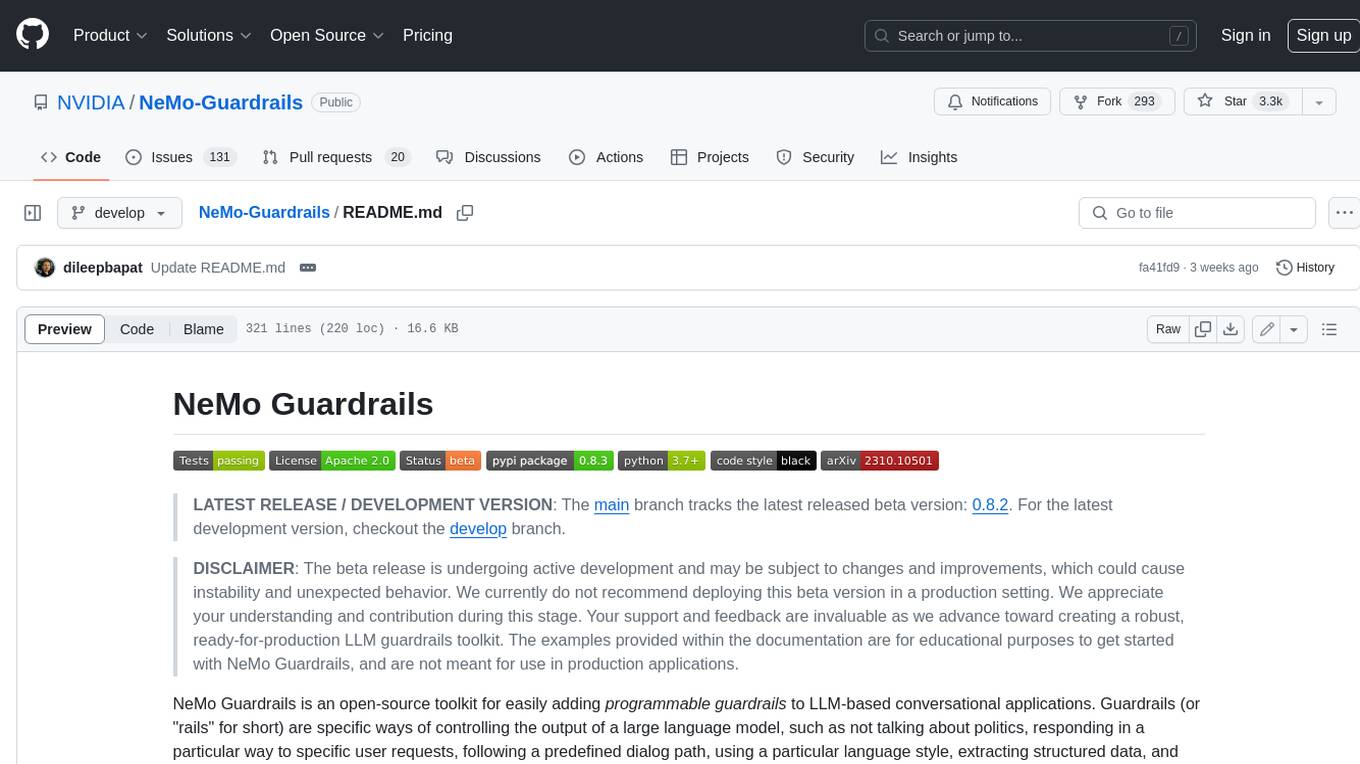
Guardrails
Guardrails is a security tool designed to help developers identify and fix security vulnerabilities in their code. It provides automated scanning and analysis of code repositories to detect potential security issues, such as sensitive data exposure, injection attacks, and insecure configurations. By integrating Guardrails into the development workflow, teams can proactively address security concerns and reduce the risk of security breaches. The tool offers detailed reports and actionable recommendations to guide developers in remediation efforts, ultimately improving the overall security posture of the codebase. Guardrails supports multiple programming languages and frameworks, making it versatile and adaptable to different development environments. With its user-friendly interface and seamless integration with popular version control systems, Guardrails empowers developers to prioritize security without compromising productivity.
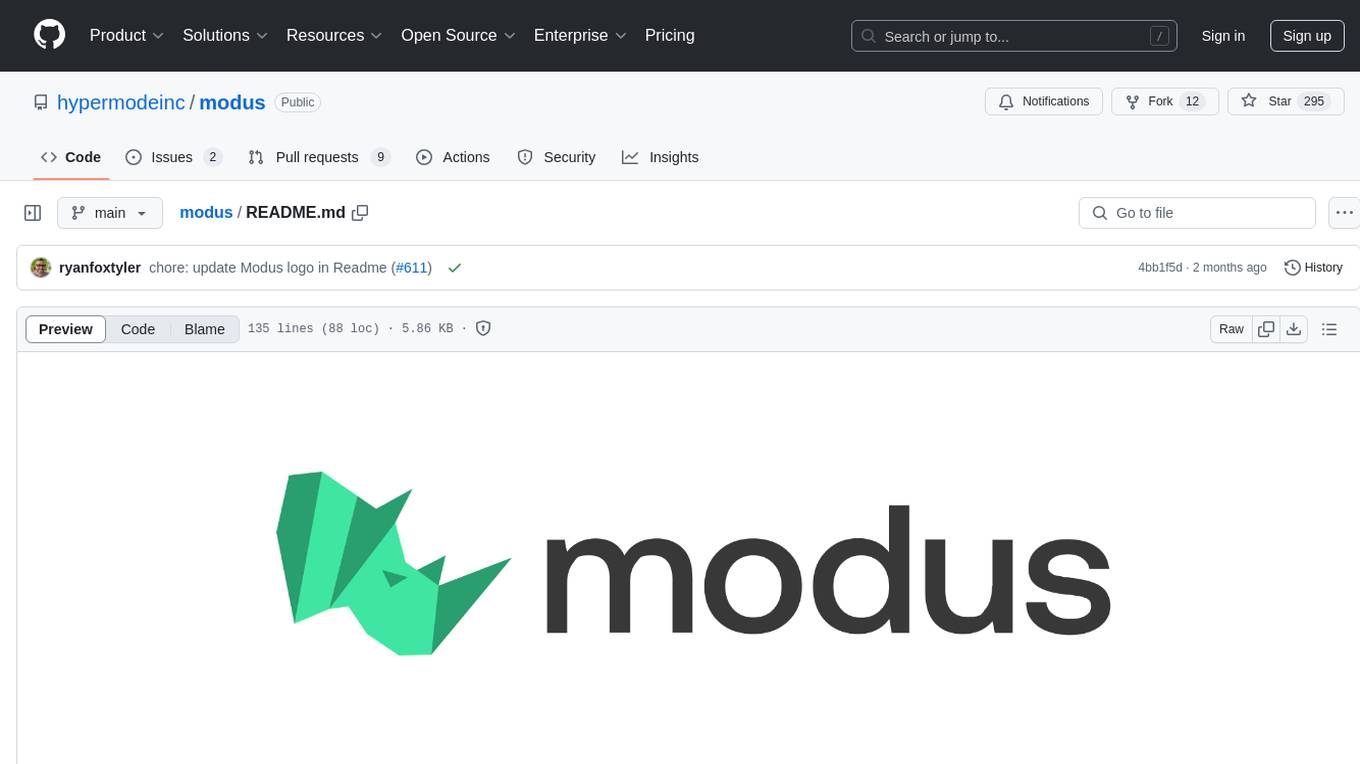
modus
Modus is an open-source, serverless framework for building APIs powered by WebAssembly. It simplifies integrating AI models, data, and business logic with sandboxed execution. Modus extracts metadata, compiles code with optimizations, caches compiled modules, prepares invocation plans, generates API schema, and activates endpoints. Users query the endpoint, and Modus loads compiled code into a sandboxed environment, runs code securely, queries data and AI models, and responds via API. It provides a production-ready scalable endpoint for AI-enabled apps, optimized for sub-second response times. Modus supports programming languages like AssemblyScript and Go, and can be hosted on Hypermode or any platform. Developed by Hypermode as an open-source project, Modus welcomes external contributions.
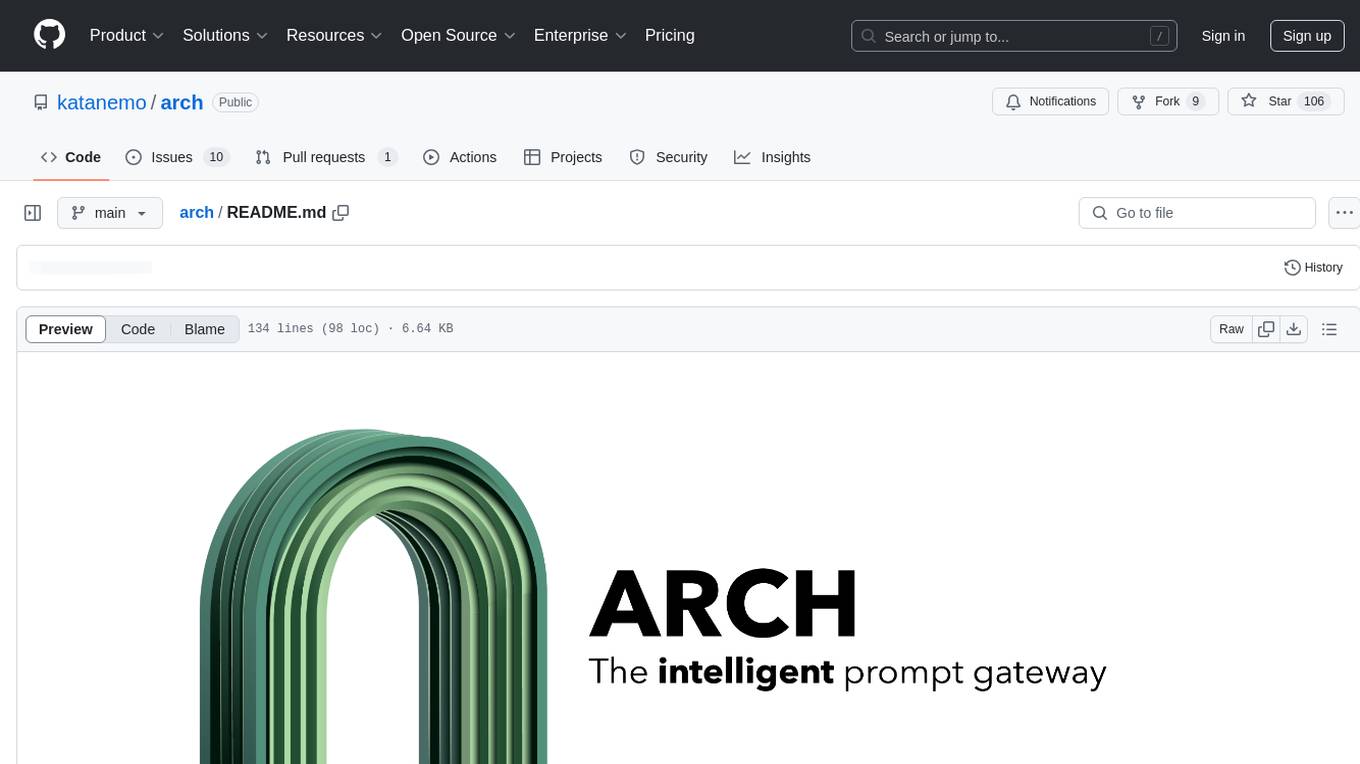
arch
Arch is an intelligent Layer 7 gateway designed to protect, observe, and personalize LLM applications with APIs. It handles tasks like detecting and rejecting jailbreak attempts, calling backend APIs, disaster recovery, and observability. Built on Envoy Proxy, it offers features like function calling, prompt guardrails, traffic management, and standards-based observability. Arch aims to improve the speed, security, and personalization of generative AI applications.
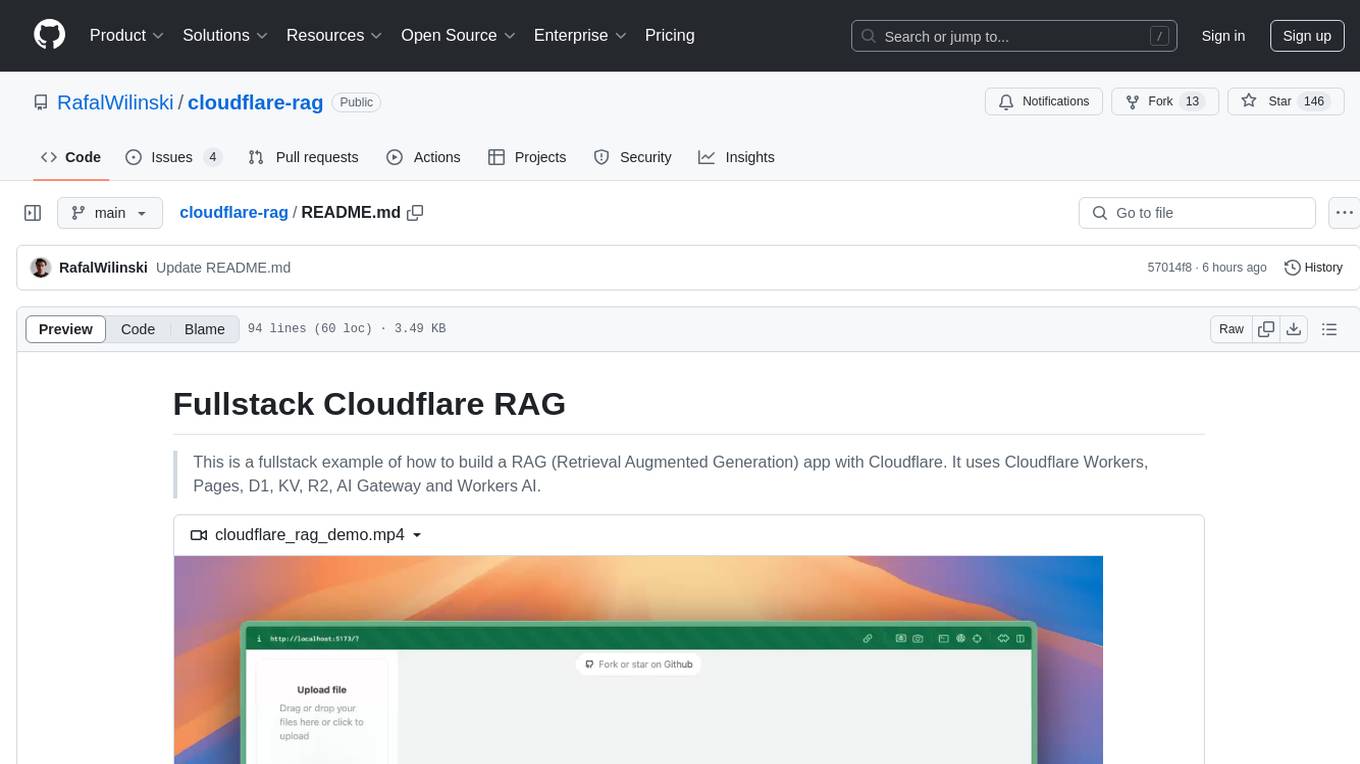
cloudflare-rag
This repository provides a fullstack example of building a Retrieval Augmented Generation (RAG) app with Cloudflare. It utilizes Cloudflare Workers, Pages, D1, KV, R2, AI Gateway, and Workers AI. The app features streaming interactions to the UI, hybrid RAG with Full-Text Search and Vector Search, switchable providers using AI Gateway, per-IP rate limiting with Cloudflare's KV, OCR within Cloudflare Worker, and Smart Placement for workload optimization. The development setup requires Node, pnpm, and wrangler CLI, along with setting up necessary primitives and API keys. Deployment involves setting up secrets and deploying the app to Cloudflare Pages. The project implements a Hybrid Search RAG approach combining Full Text Search against D1 and Hybrid Search with embeddings against Vectorize to enhance context for the LLM.
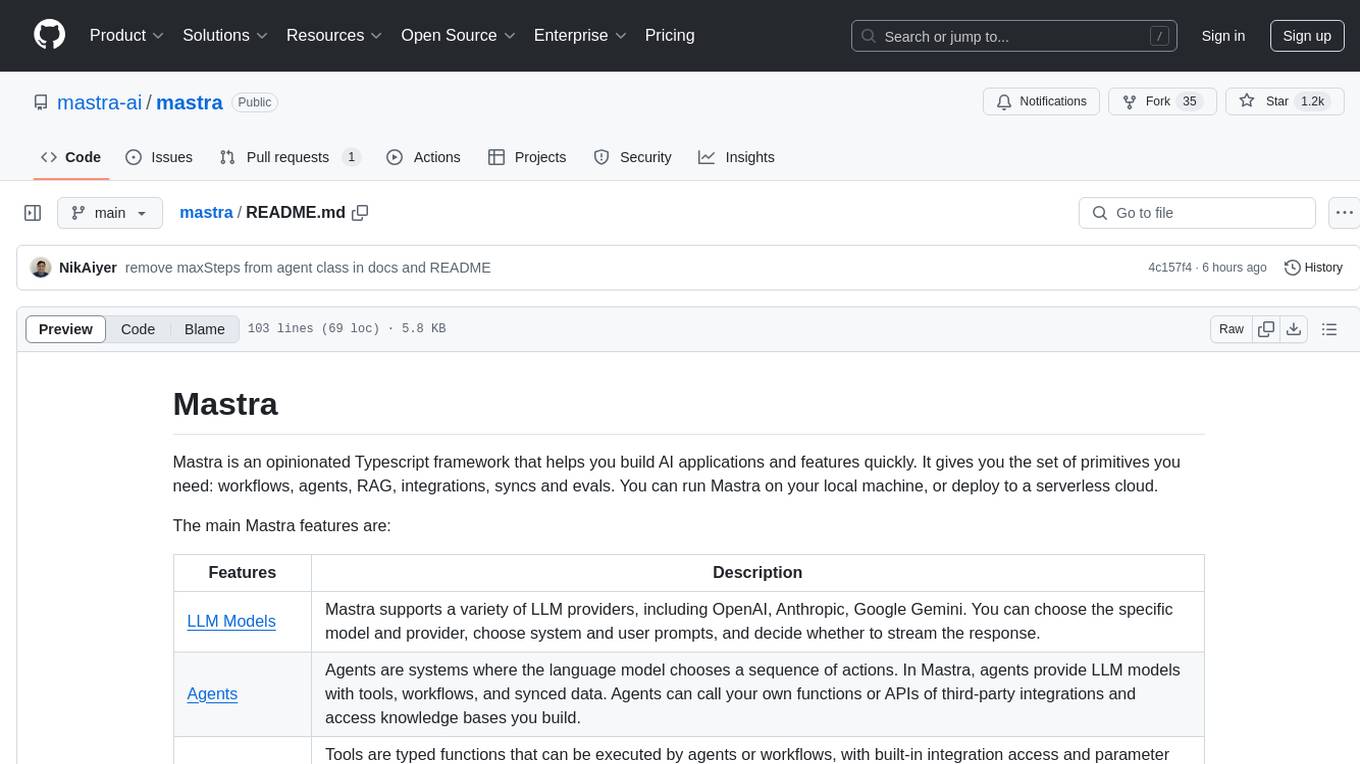
mastra
Mastra is an opinionated Typescript framework designed to help users quickly build AI applications and features. It provides primitives such as workflows, agents, RAG, integrations, syncs, and evals. Users can run Mastra locally or deploy it to a serverless cloud. The framework supports various LLM providers, offers tools for building language models, workflows, and accessing knowledge bases. It includes features like durable graph-based state machines, retrieval-augmented generation, integrations, syncs, and automated tests for evaluating LLM outputs.
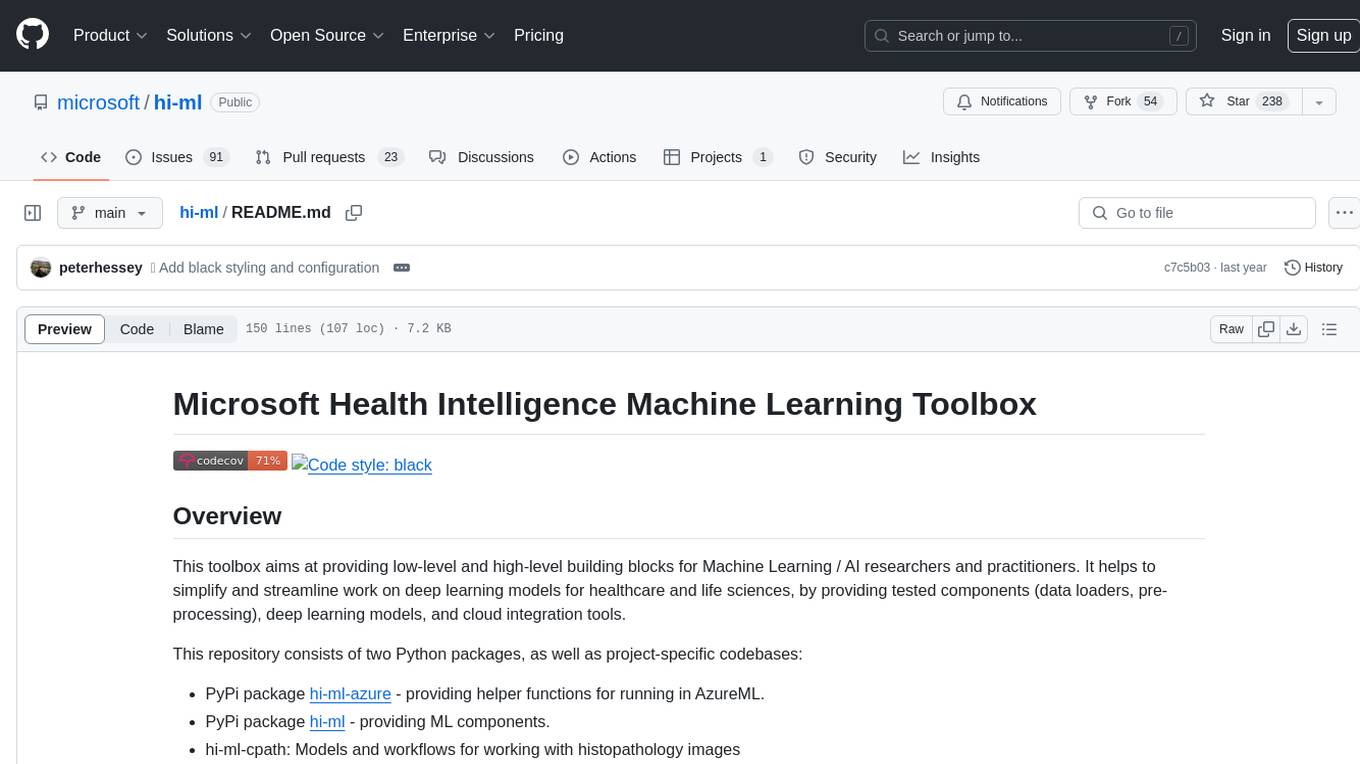
hi-ml
The Microsoft Health Intelligence Machine Learning Toolbox is a repository that provides low-level and high-level building blocks for Machine Learning / AI researchers and practitioners. It simplifies and streamlines work on deep learning models for healthcare and life sciences by offering tested components such as data loaders, pre-processing tools, deep learning models, and cloud integration utilities. The repository includes two Python packages, 'hi-ml-azure' for helper functions in AzureML, 'hi-ml' for ML components, and 'hi-ml-cpath' for models and workflows related to histopathology images.
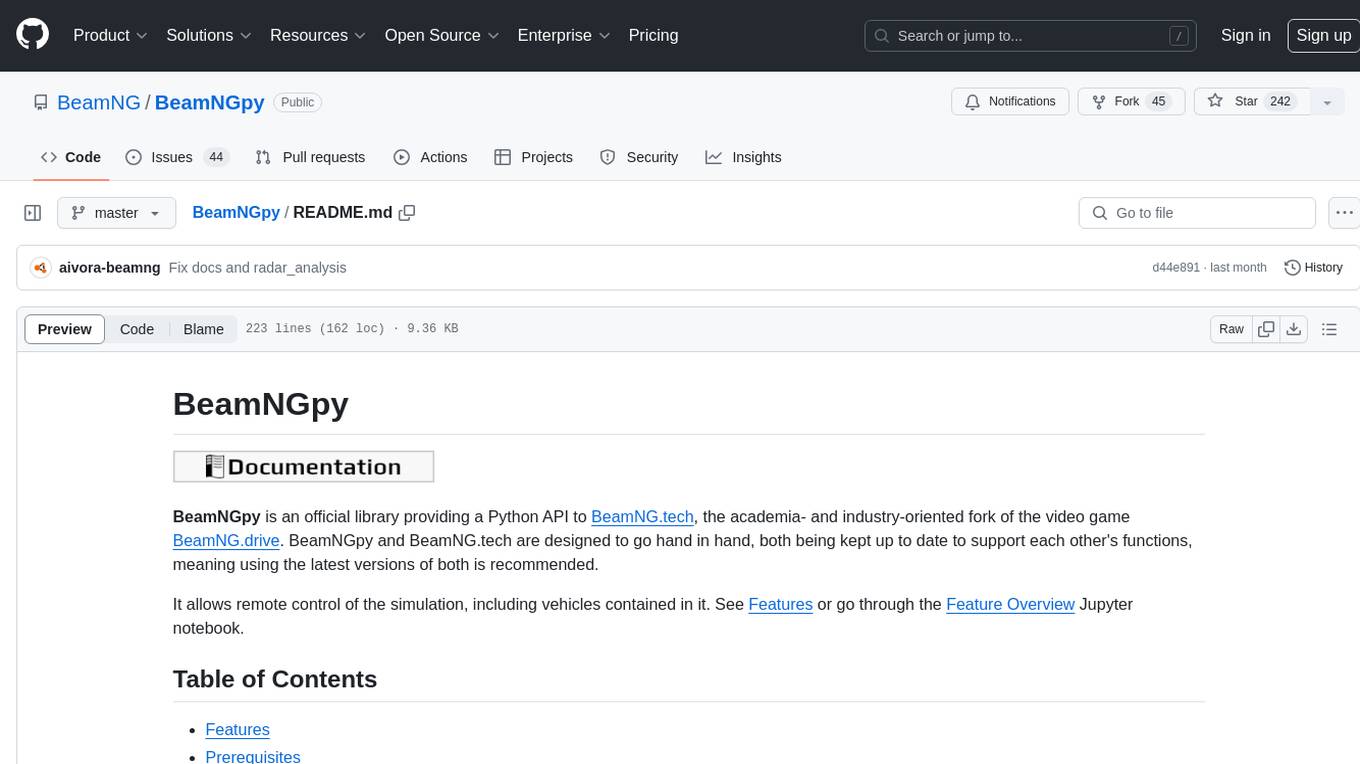
BeamNGpy
BeamNGpy is an official Python library providing an API to interact with BeamNG.tech, a video game focused on academia and industry. It allows remote control of vehicles, AI-controlled vehicles, dynamic sensor models, access to road network and scenario objects, and multiple clients. The library comes with low-level functions and higher-level interfaces for complex actions. BeamNGpy requires BeamNG.tech for usage and offers compatibility information for different versions. It also provides troubleshooting tips and encourages user contributions.
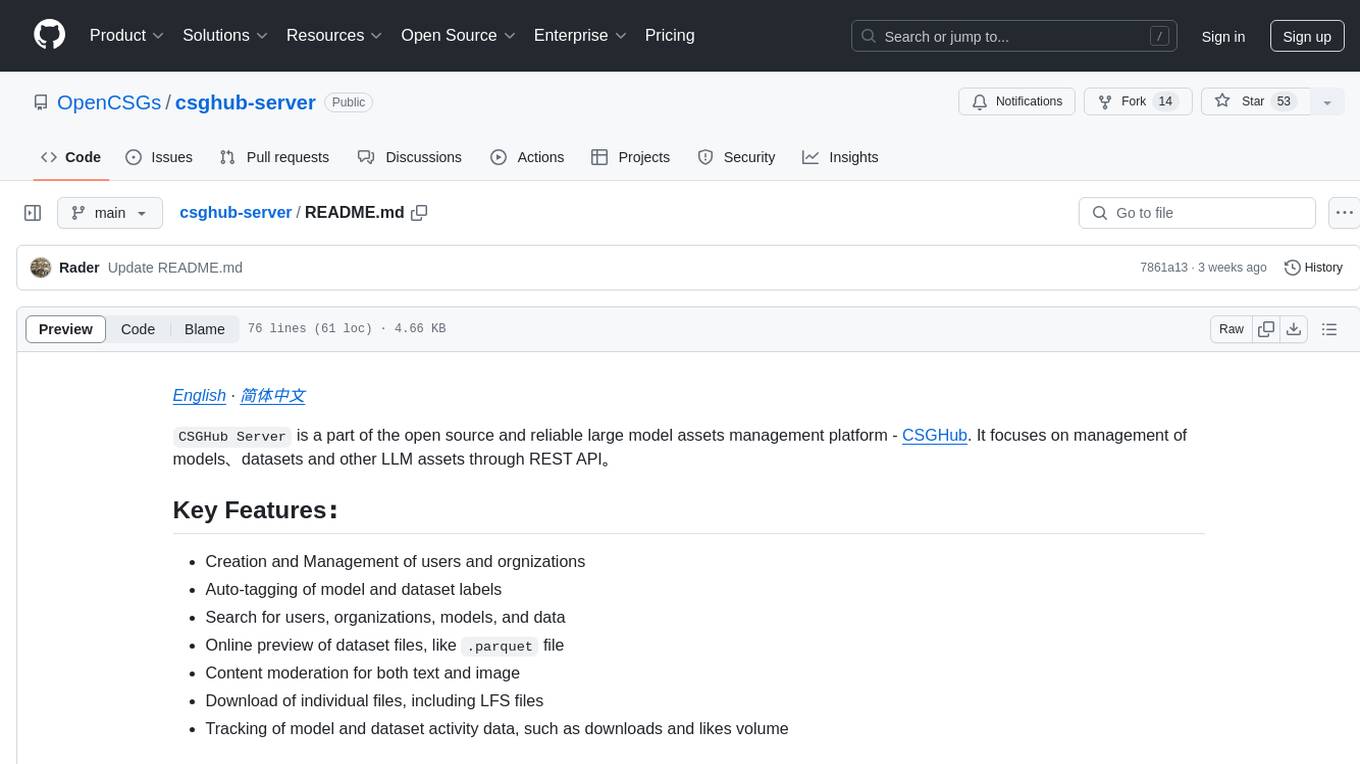
csghub-server
CSGHub Server is a part of the open source and reliable large model assets management platform - CSGHub. It focuses on management of models, datasets, and other LLM assets through REST API. Key features include creation and management of users and organizations, auto-tagging of model and dataset labels, search functionality, online preview of dataset files, content moderation for text and image, download of individual files, tracking of model and dataset activity data. The tool is extensible and customizable, supporting different git servers, flexible LFS storage system configuration, and content moderation options. The roadmap includes support for more Git servers, Git LFS, dataset online viewer, model/dataset auto-tag, S3 protocol support, model format conversion, and model one-click deploy. The project is licensed under Apache 2.0 and welcomes contributions.
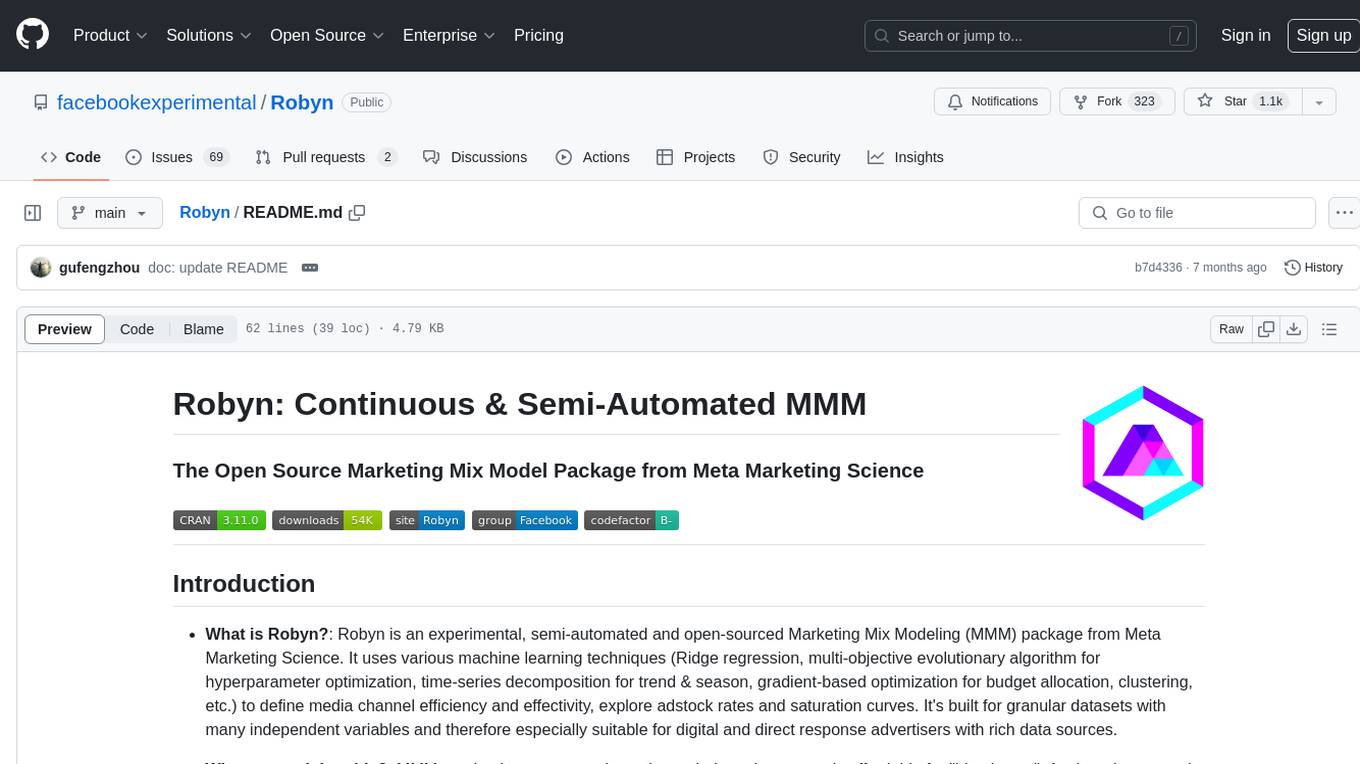
Robyn
Robyn is an experimental, semi-automated and open-sourced Marketing Mix Modeling (MMM) package from Meta Marketing Science. It uses various machine learning techniques to define media channel efficiency and effectivity, explore adstock rates and saturation curves. Built for granular datasets with many independent variables, especially suitable for digital and direct response advertisers with rich data sources. Aiming to democratize MMM, make it accessible for advertisers of all sizes, and contribute to the measurement landscape.
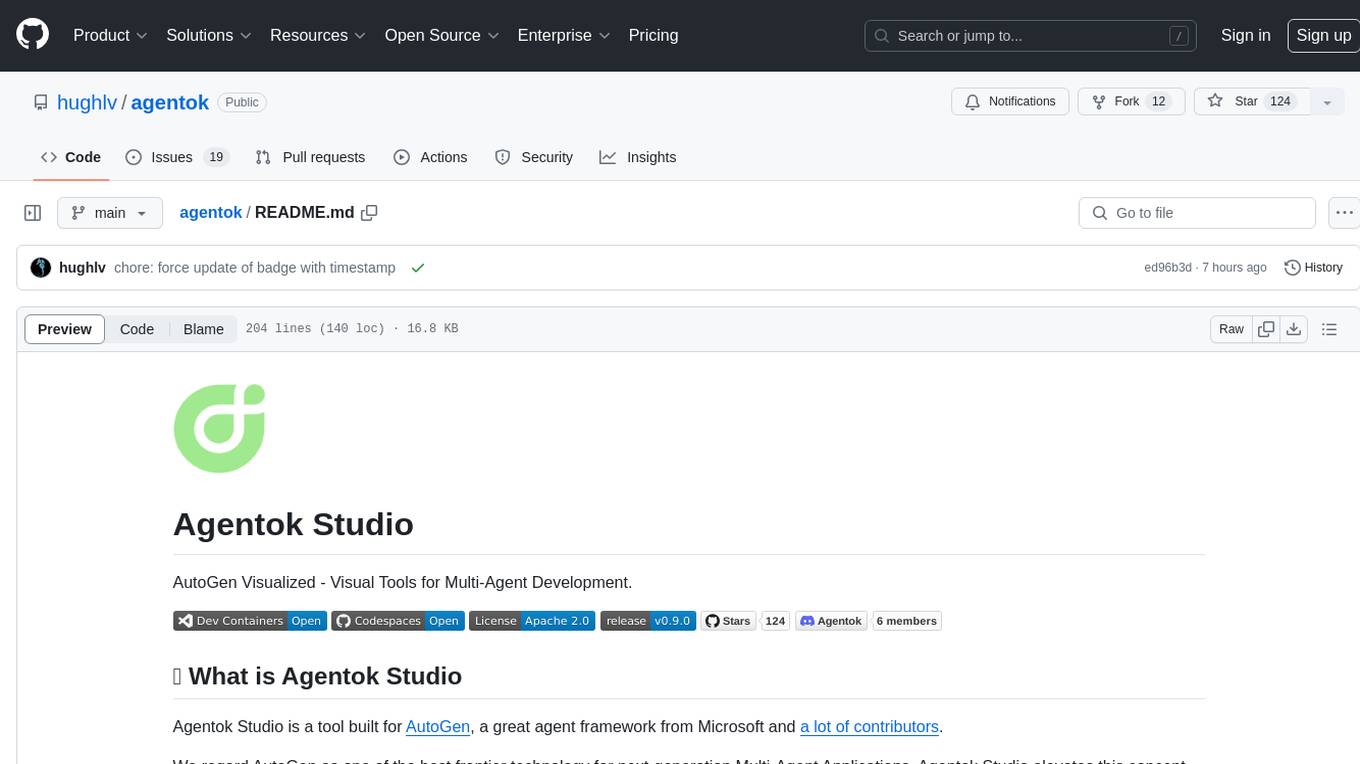
agentok
Agentok Studio is a visual tool built for AutoGen, a cutting-edge agent framework from Microsoft and various contributors. It offers intuitive visual tools to simplify the construction and management of complex agent-based workflows. Users can create workflows visually as graphs, chat with agents, and share flow templates. The tool is designed to streamline the development process for creators and developers working on next-generation Multi-Agent Applications.
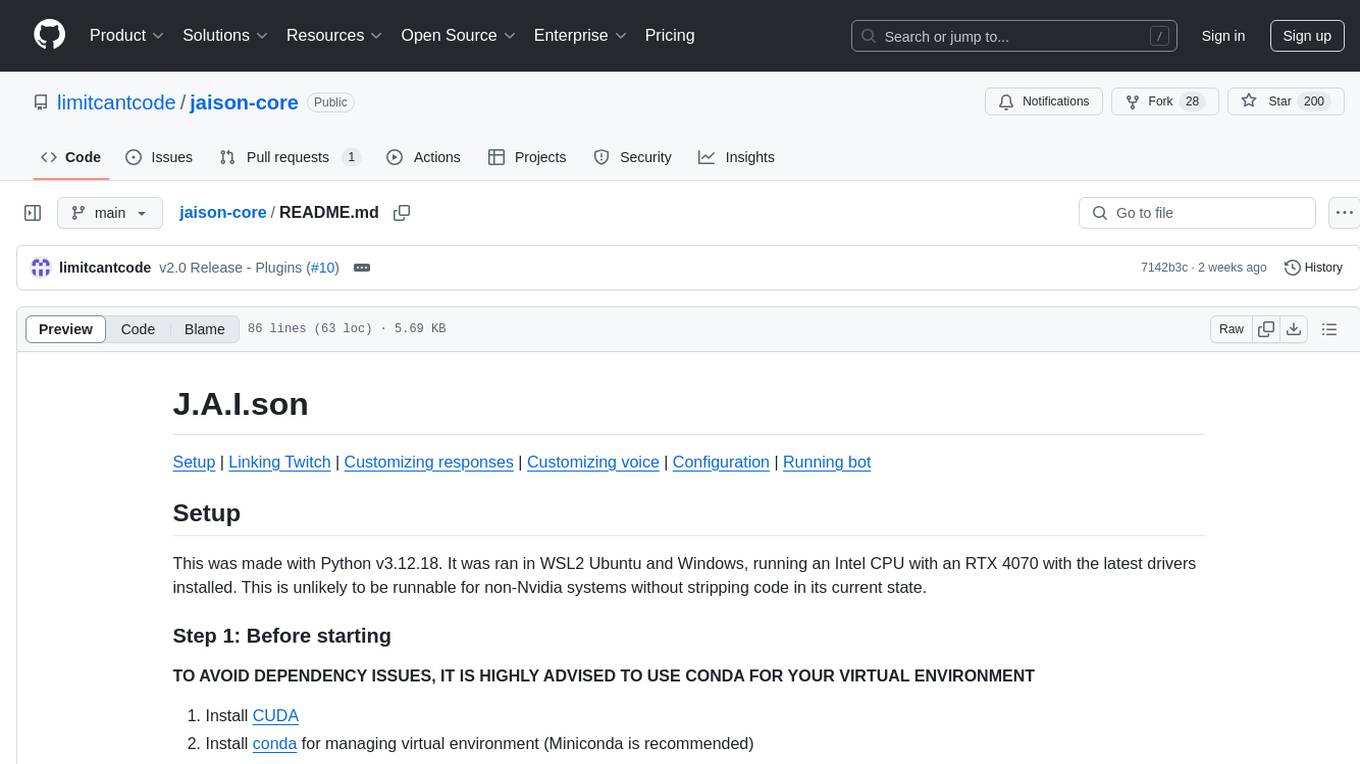
jaison-core
J.A.I.son is a Python project designed for generating responses using various components and applications. It requires specific plugins like STT, T2T, TTSG, and TTSC to function properly. Users can customize responses, voice, and configurations. The project provides a Discord bot, Twitch events and chat integration, and VTube Studio Animation Hotkeyer. It also offers features for managing conversation history, training AI models, and monitoring conversations.
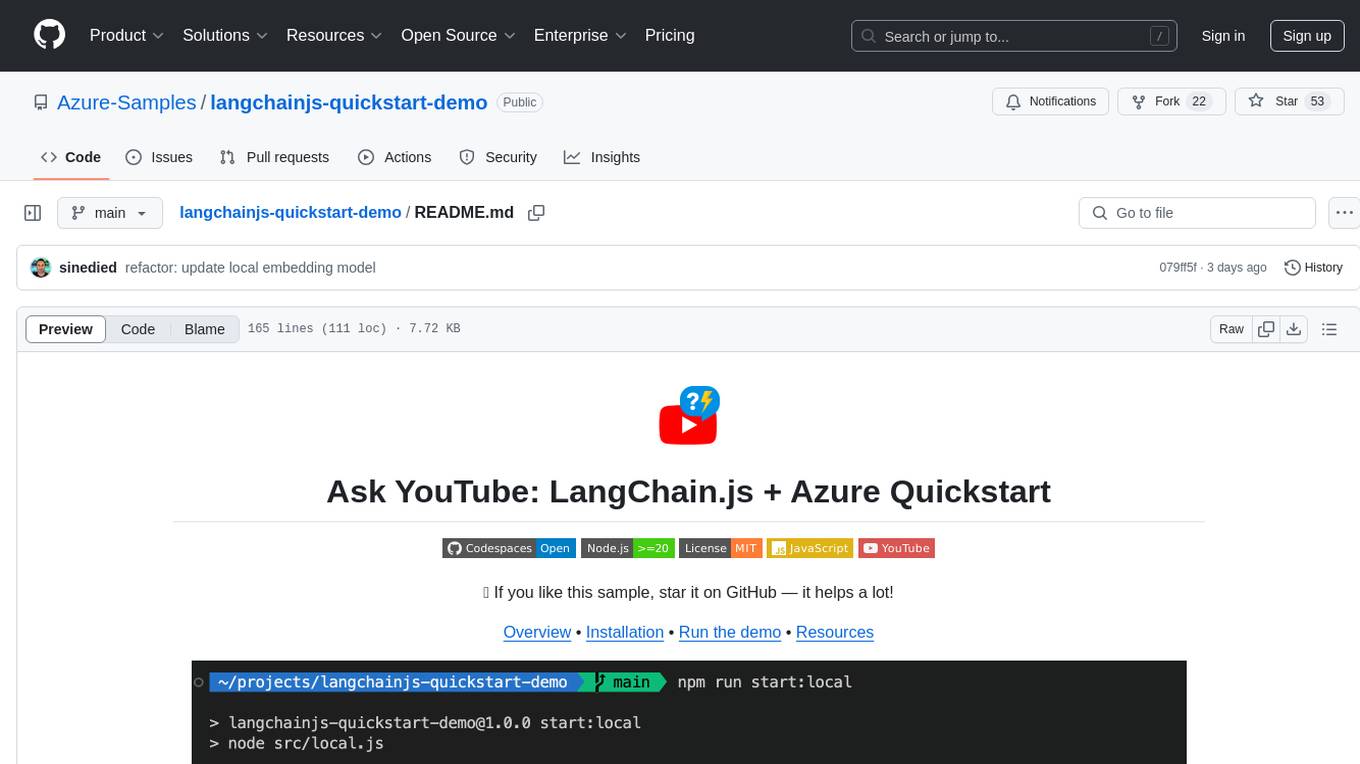
langchainjs-quickstart-demo
Discover the journey of building a generative AI application using LangChain.js and Azure. This demo explores the development process from idea to production, using a RAG-based approach for a Q&A system based on YouTube video transcripts. The application allows to ask text-based questions about a YouTube video and uses the transcript of the video to generate responses. The code comes in two versions: local prototype using FAISS and Ollama with LLaMa3 model for completion and all-minilm-l6-v2 for embeddings, and Azure cloud version using Azure AI Search and GPT-4 Turbo model for completion and text-embedding-3-large for embeddings. Either version can be run as an API using the Azure Functions runtime.
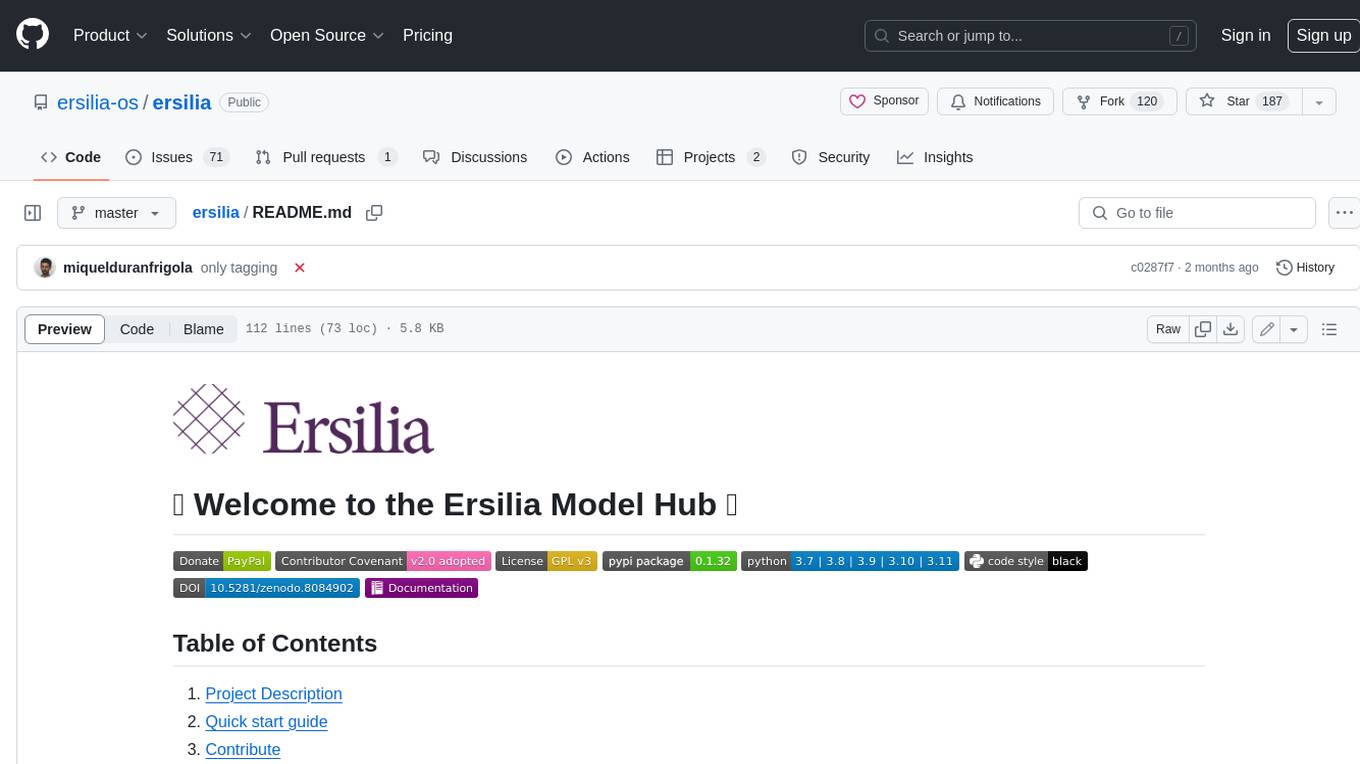
ersilia
The Ersilia Model Hub is a unified platform of pre-trained AI/ML models dedicated to infectious and neglected disease research. It offers an open-source, low-code solution that provides seamless access to AI/ML models for drug discovery. Models housed in the hub come from two sources: published models from literature (with due third-party acknowledgment) and custom models developed by the Ersilia team or contributors.
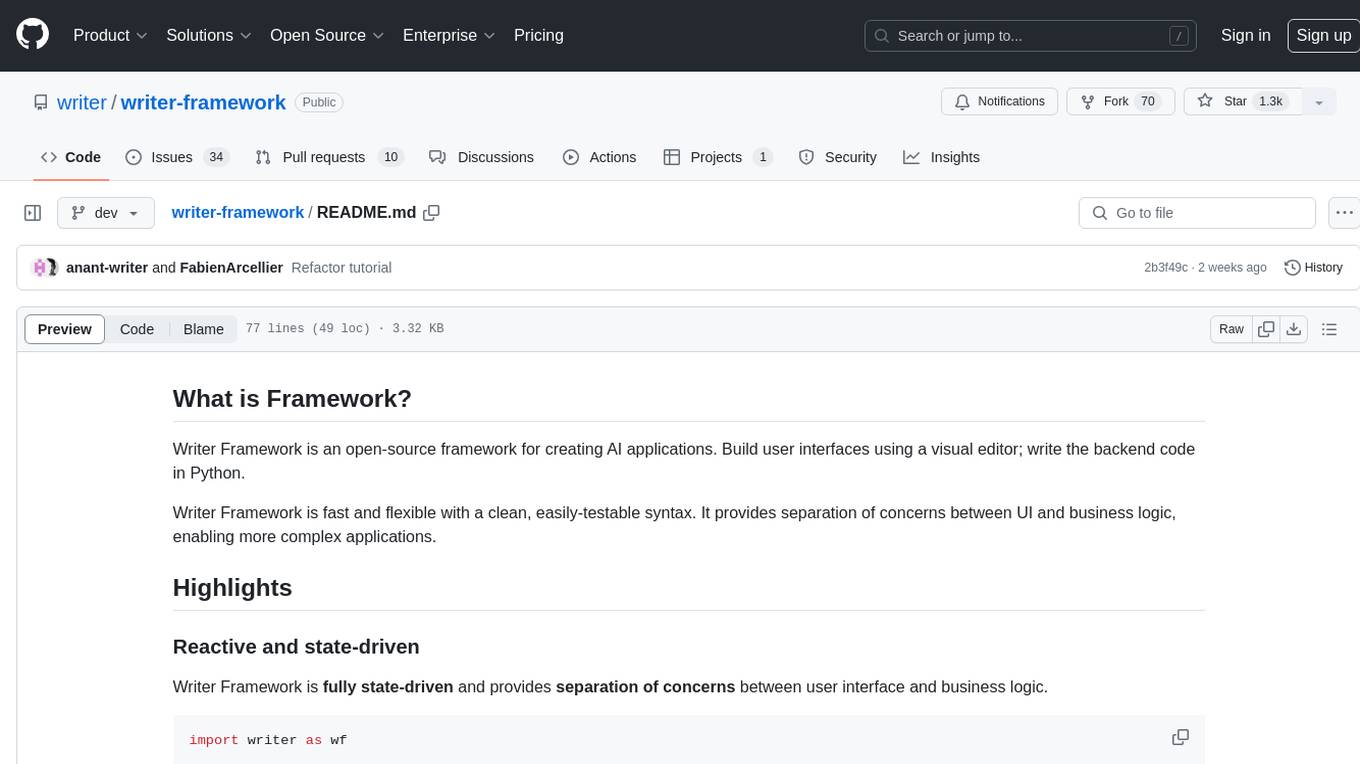
writer-framework
Writer Framework is an open-source framework for creating AI applications. It allows users to build user interfaces using a visual editor and write the backend code in Python. The framework is fast, flexible, and provides separation of concerns between UI and business logic. It is reactive and state-driven, highly customizable without requiring CSS, fast in event handling, developer-friendly with easy installation and quick start options, and contains full documentation for using its AI module and deployment options.
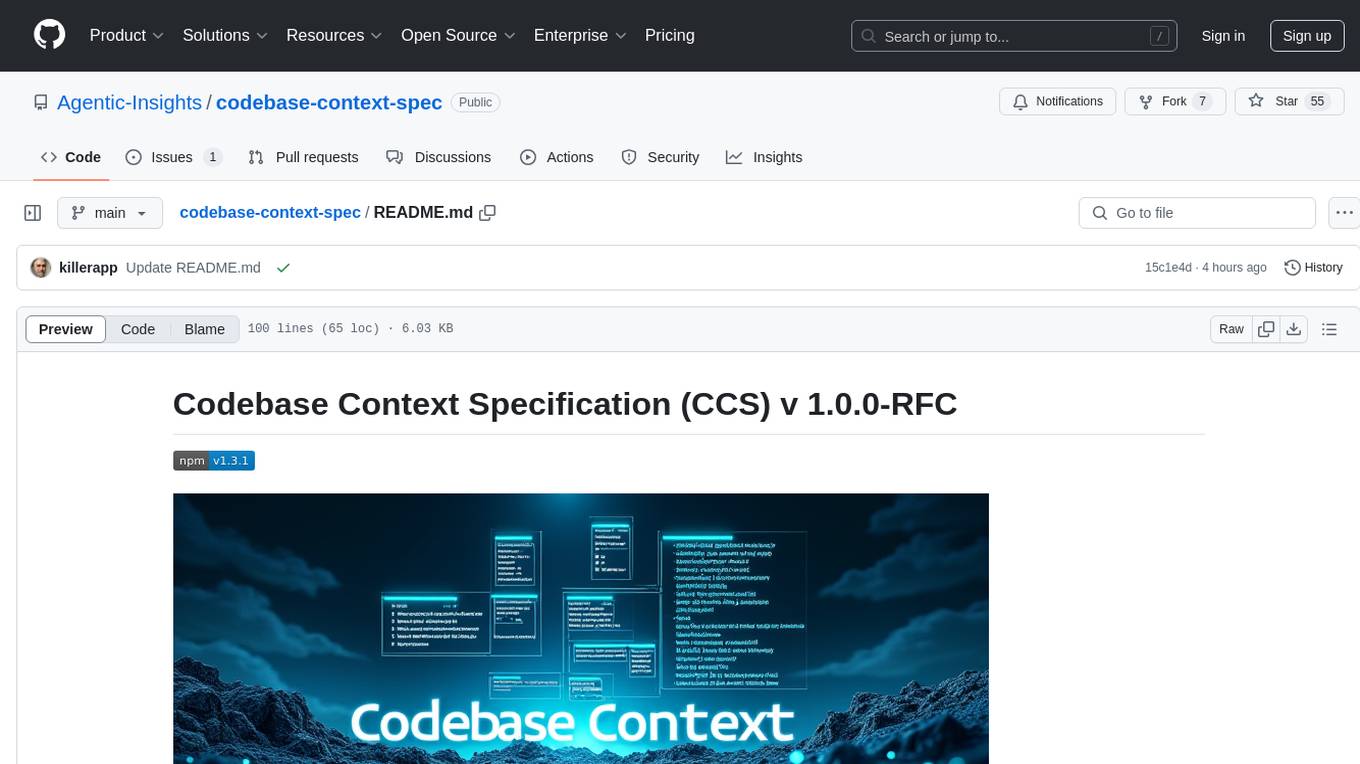
codebase-context-spec
The Codebase Context Specification (CCS) project aims to standardize embedding contextual information within codebases to enhance understanding for both AI and human developers. It introduces a convention similar to `.env` and `.editorconfig` files but focused on documenting code for both AI and humans. By providing structured contextual metadata, collaborative documentation guidelines, and standardized context files, developers can improve code comprehension, collaboration, and development efficiency. The project includes a linter for validating context files and provides guidelines for using the specification with AI assistants. Tooling recommendations suggest creating memory systems, IDE plugins, AI model integrations, and agents for context creation and utilization. Future directions include integration with existing documentation systems, dynamic context generation, and support for explicit context overriding.
For similar tasks

hashbrown
Hashbrown is a lightweight and efficient hashing library for Python, designed to provide easy-to-use cryptographic hashing functions for secure data storage and transmission. It supports a variety of hashing algorithms, including MD5, SHA-1, SHA-256, and SHA-512, allowing users to generate hash values for strings, files, and other data types. With Hashbrown, developers can quickly implement data integrity checks, password hashing, digital signatures, and other security features in their Python applications.
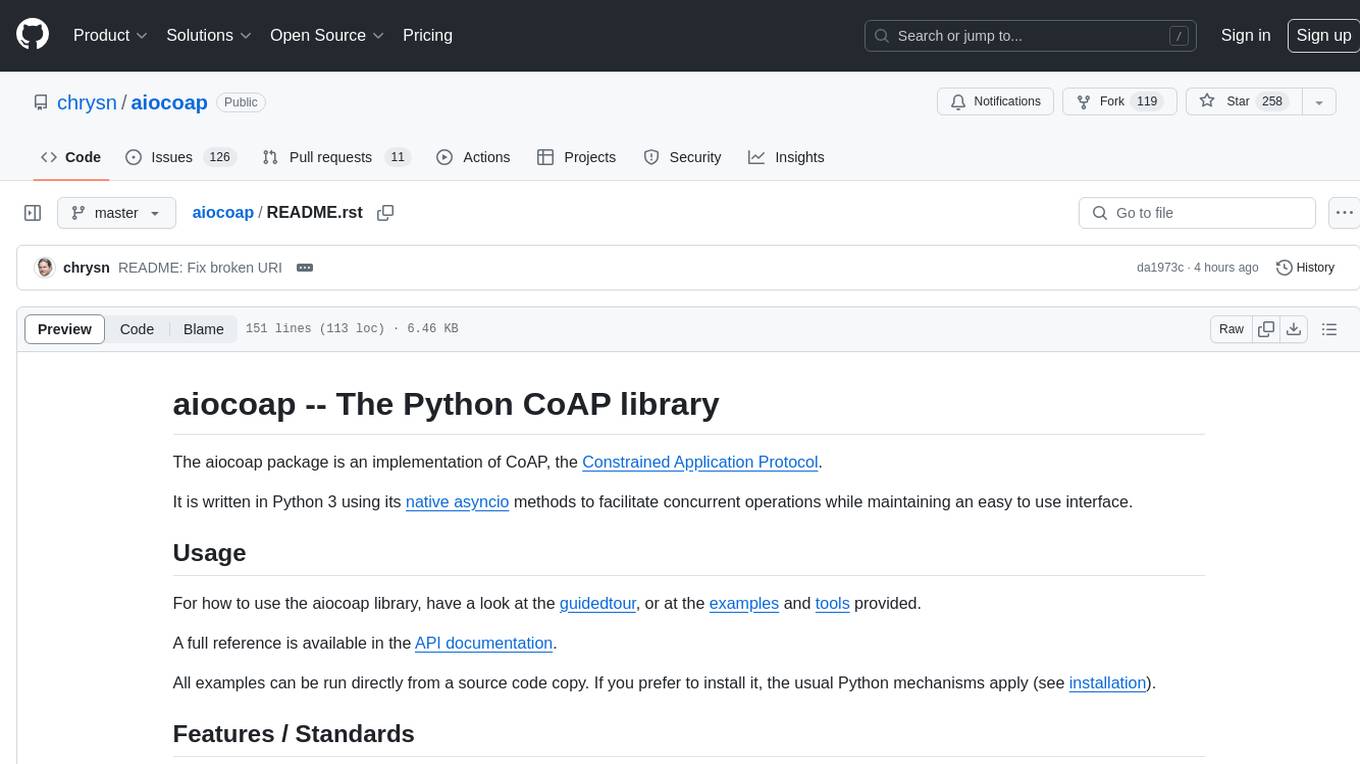
aiocoap
aiocoap is a Python library that implements the Constrained Application Protocol (CoAP) using native asyncio methods in Python 3. It supports various CoAP standards such as RFC7252, RFC7641, RFC7959, RFC8323, RFC7967, RFC8132, RFC9176, RFC8613, and draft-ietf-core-oscore-groupcomm-17. The library provides features for clients and servers, including multicast support, blockwise transfer, CoAP over TCP, TLS, and WebSockets, No-Response, PATCH/FETCH, OSCORE, and Group OSCORE. It offers an easy-to-use interface for concurrent operations and is suitable for IoT applications.
For similar jobs
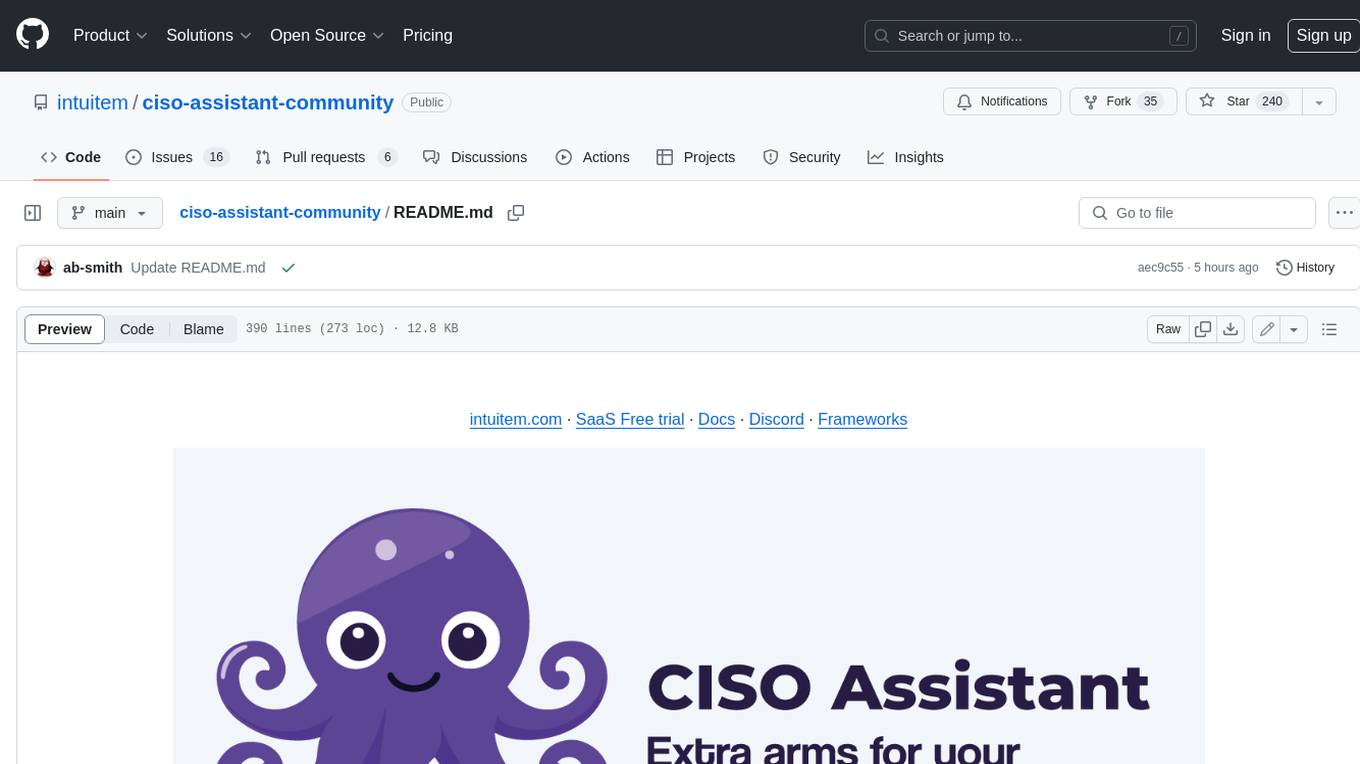
ciso-assistant-community
CISO Assistant is a tool that helps organizations manage their cybersecurity posture and compliance. It provides a centralized platform for managing security controls, threats, and risks. CISO Assistant also includes a library of pre-built frameworks and tools to help organizations quickly and easily implement best practices.
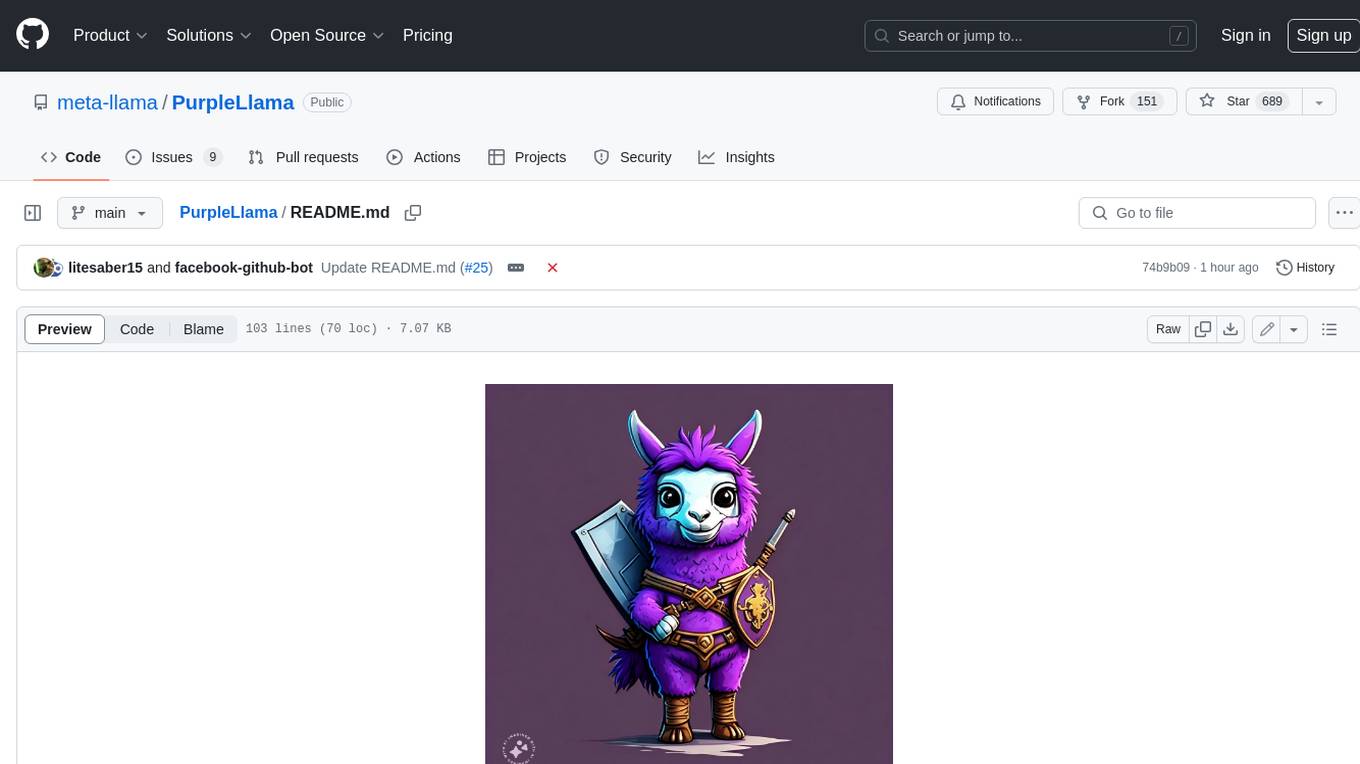
PurpleLlama
Purple Llama is an umbrella project that aims to provide tools and evaluations to support responsible development and usage of generative AI models. It encompasses components for cybersecurity and input/output safeguards, with plans to expand in the future. The project emphasizes a collaborative approach, borrowing the concept of purple teaming from cybersecurity, to address potential risks and challenges posed by generative AI. Components within Purple Llama are licensed permissively to foster community collaboration and standardize the development of trust and safety tools for generative AI.
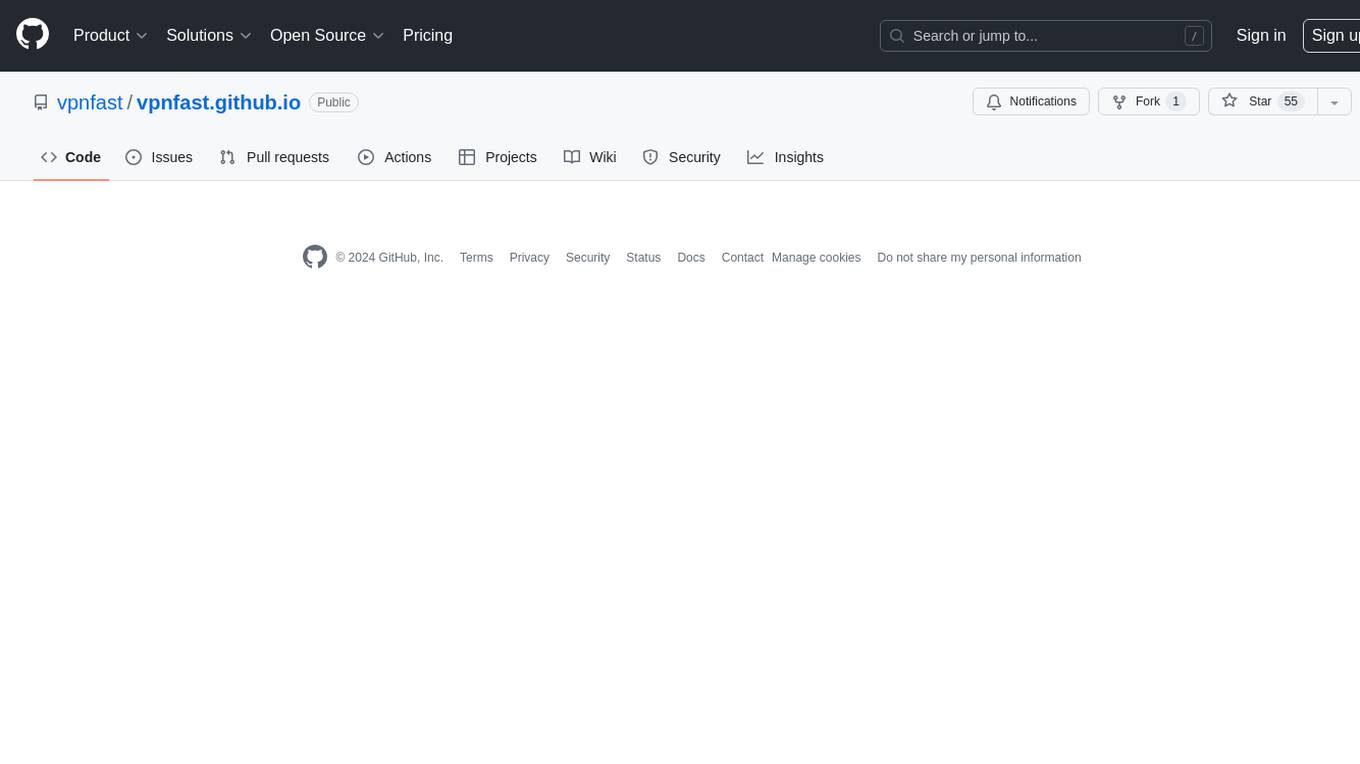
vpnfast.github.io
VPNFast is a lightweight and fast VPN service provider that offers secure and private internet access. With VPNFast, users can protect their online privacy, bypass geo-restrictions, and secure their internet connection from hackers and snoopers. The service provides high-speed servers in multiple locations worldwide, ensuring a reliable and seamless VPN experience for users. VPNFast is easy to use, with a user-friendly interface and simple setup process. Whether you're browsing the web, streaming content, or accessing sensitive information, VPNFast helps you stay safe and anonymous online.
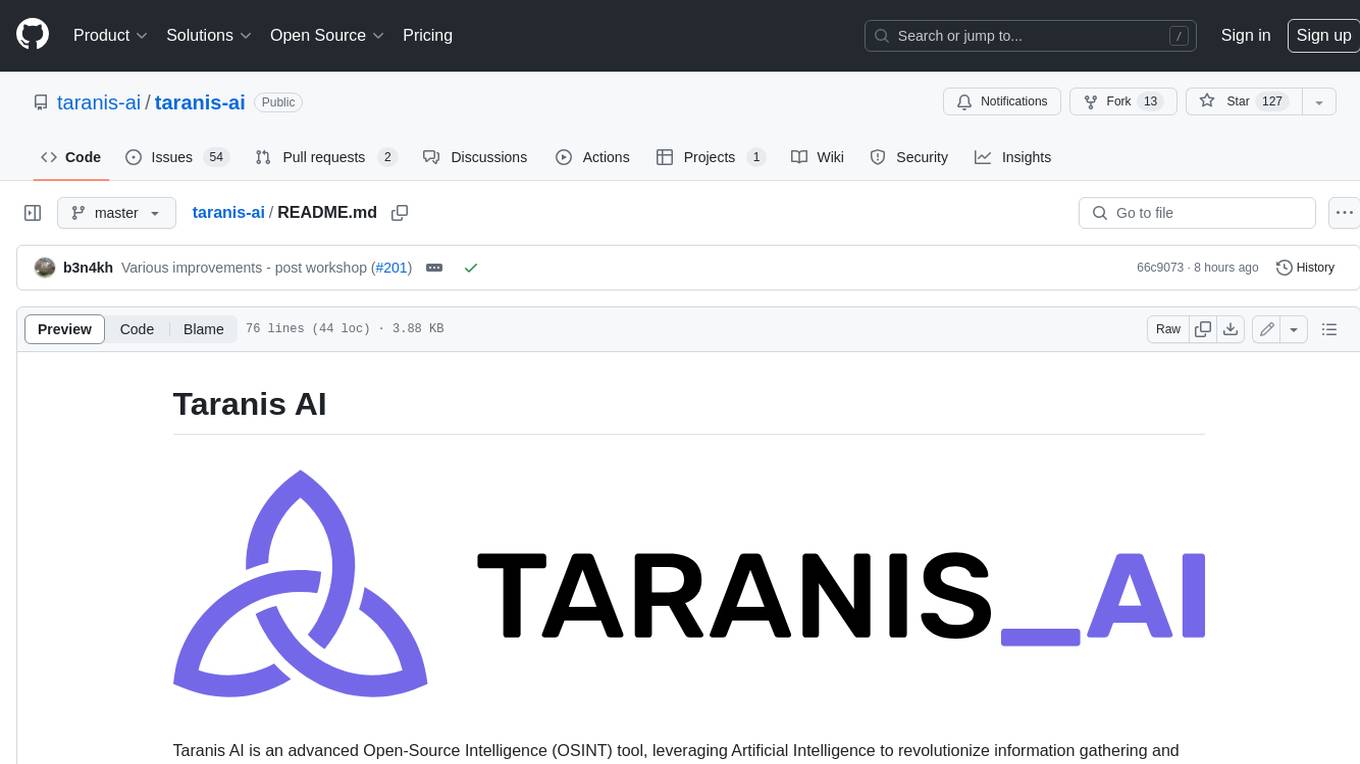
taranis-ai
Taranis AI is an advanced Open-Source Intelligence (OSINT) tool that leverages Artificial Intelligence to revolutionize information gathering and situational analysis. It navigates through diverse data sources like websites to collect unstructured news articles, utilizing Natural Language Processing and Artificial Intelligence to enhance content quality. Analysts then refine these AI-augmented articles into structured reports that serve as the foundation for deliverables such as PDF files, which are ultimately published.
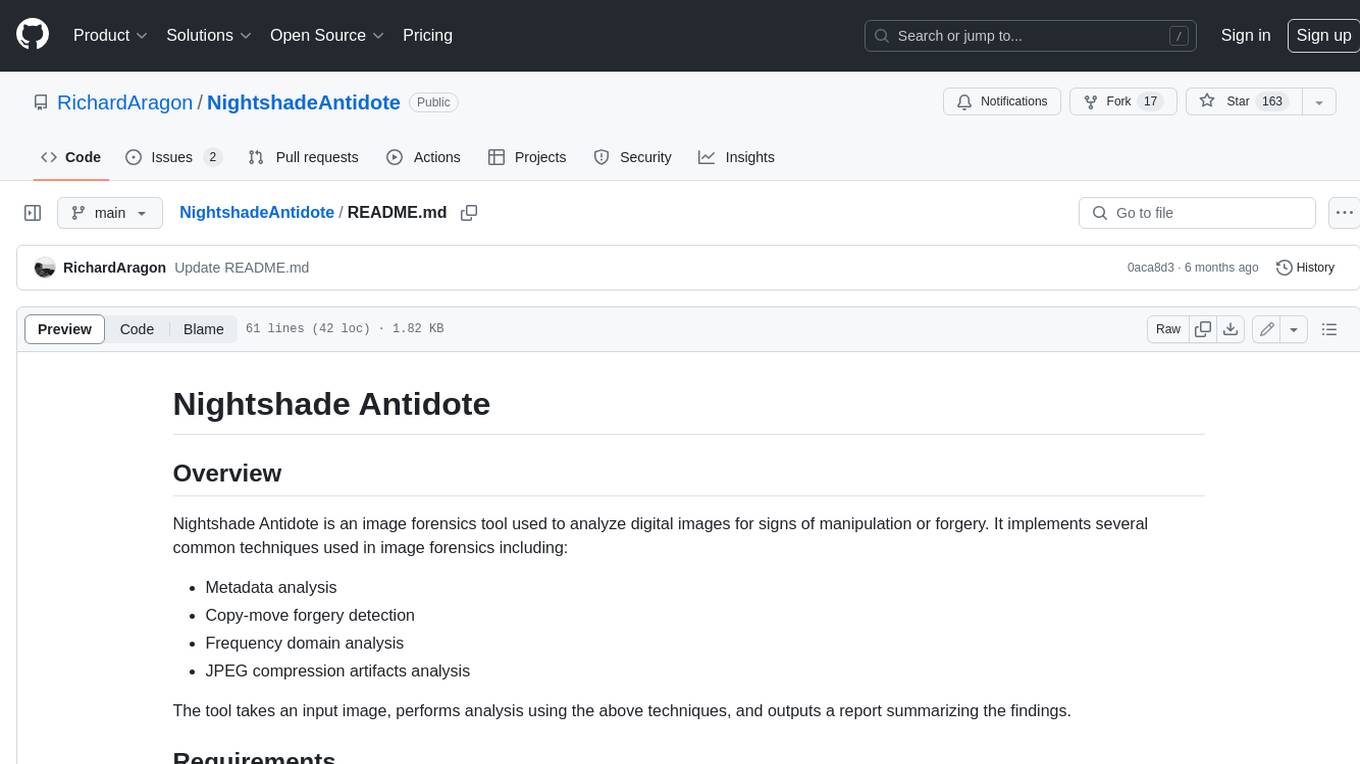
NightshadeAntidote
Nightshade Antidote is an image forensics tool used to analyze digital images for signs of manipulation or forgery. It implements several common techniques used in image forensics including metadata analysis, copy-move forgery detection, frequency domain analysis, and JPEG compression artifacts analysis. The tool takes an input image, performs analysis using the above techniques, and outputs a report summarizing the findings.
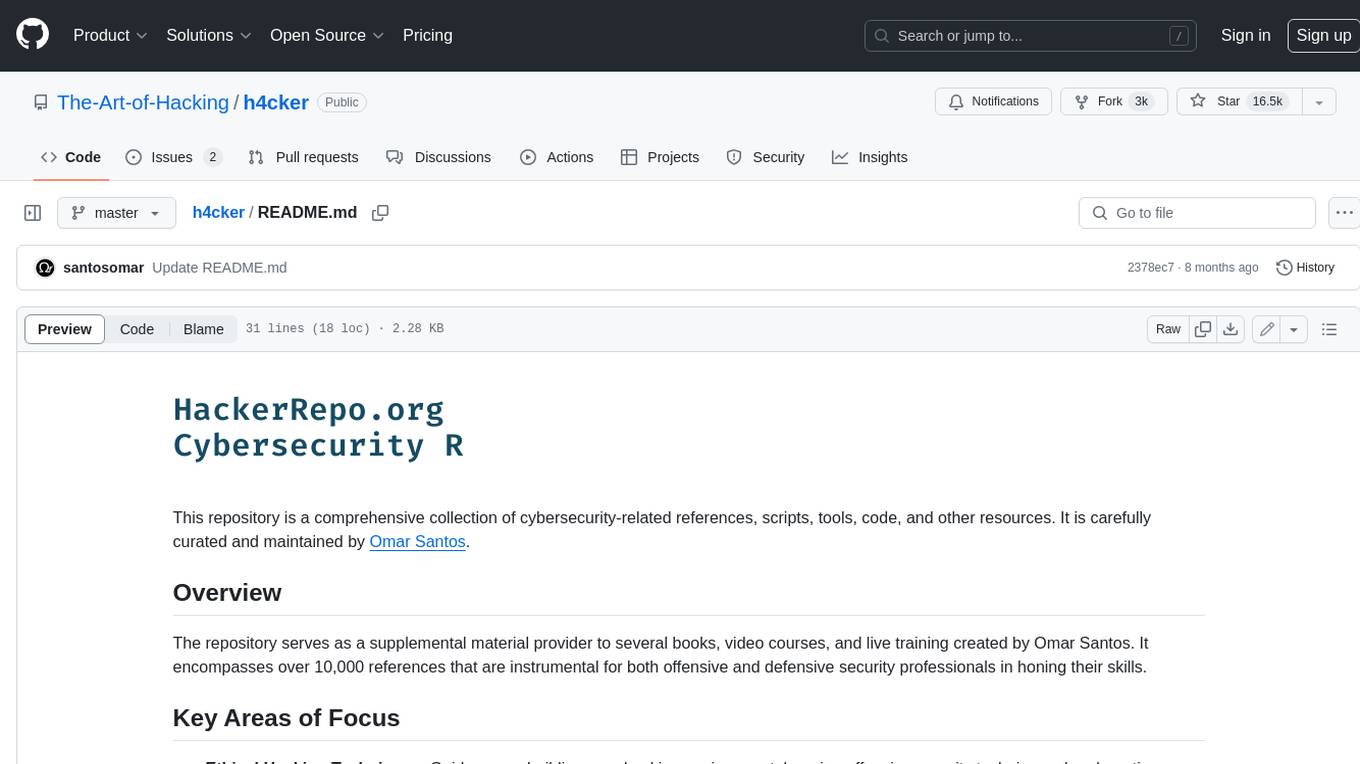
h4cker
This repository is a comprehensive collection of cybersecurity-related references, scripts, tools, code, and other resources. It is carefully curated and maintained by Omar Santos. The repository serves as a supplemental material provider to several books, video courses, and live training created by Omar Santos. It encompasses over 10,000 references that are instrumental for both offensive and defensive security professionals in honing their skills.
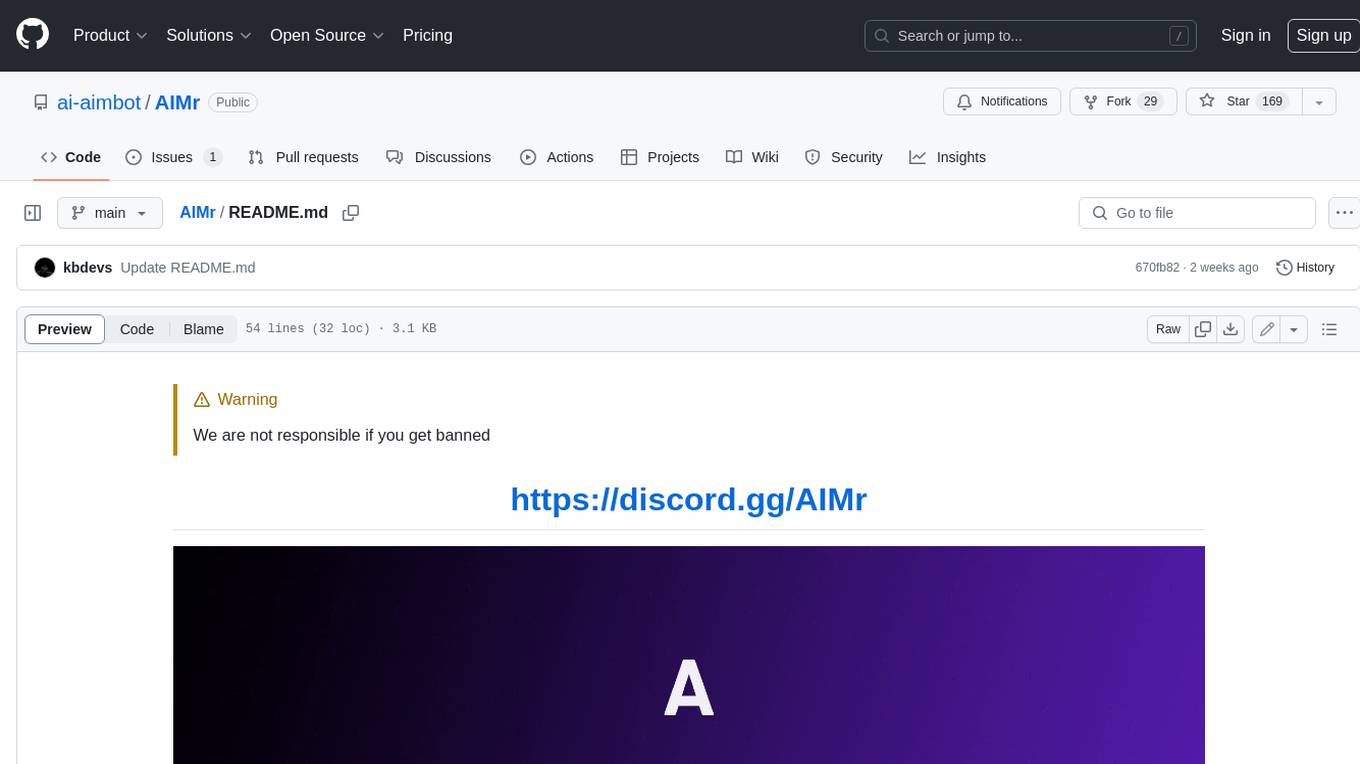
AIMr
AIMr is an AI aimbot tool written in Python that leverages modern technologies to achieve an undetected system with a pleasing appearance. It works on any game that uses human-shaped models. To optimize its performance, users should build OpenCV with CUDA. For Valorant, additional perks in the Discord and an Arduino Leonardo R3 are required.
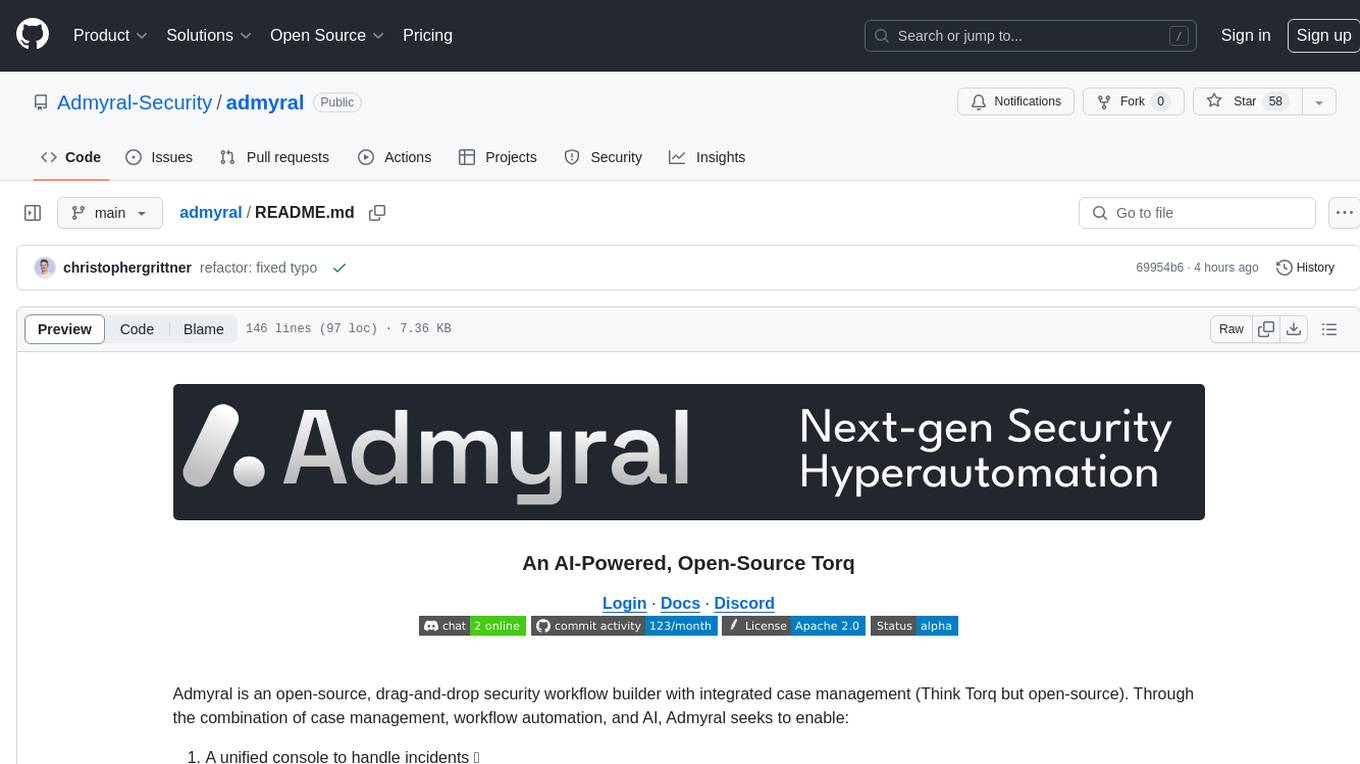
admyral
Admyral is an open-source Cybersecurity Automation & Investigation Assistant that provides a unified console for investigations and incident handling, workflow automation creation, automatic alert investigation, and next step suggestions for analysts. It aims to tackle alert fatigue and automate security workflows effectively by offering features like workflow actions, AI actions, case management, alert handling, and more. Admyral combines security automation and case management to streamline incident response processes and improve overall security posture. The tool is open-source, transparent, and community-driven, allowing users to self-host, contribute, and collaborate on integrations and features.
